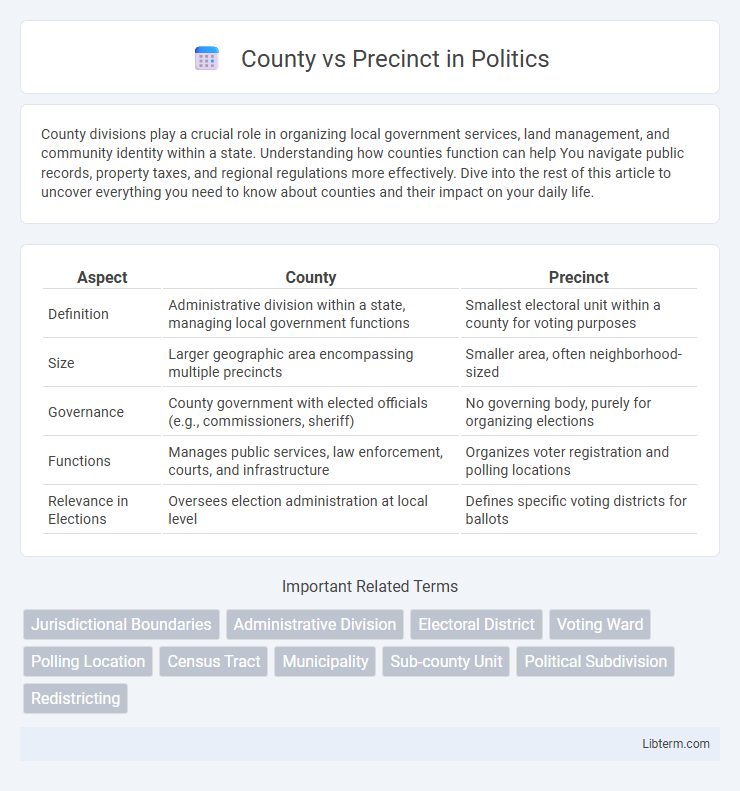County divisions play a crucial role in organizing local government services, land management, and community identity within a state. Understanding how counties function can help You navigate public records, property taxes, and regional regulations more effectively. Dive into the rest of this article to uncover everything you need to know about counties and their impact on your daily life.
Table of Comparison
| Aspect | County | Precinct |
|---|---|---|
| Definition | Administrative division within a state, managing local government functions | Smallest electoral unit within a county for voting purposes |
| Size | Larger geographic area encompassing multiple precincts | Smaller area, often neighborhood-sized |
| Governance | County government with elected officials (e.g., commissioners, sheriff) | No governing body, purely for organizing elections |
| Functions | Manages public services, law enforcement, courts, and infrastructure | Organizes voter registration and polling locations |
| Relevance in Elections | Oversees election administration at local level | Defines specific voting districts for ballots |
Understanding the Basics: County vs Precinct
Counties serve as larger administrative regions encompassing multiple precincts, which are smaller, localized voting districts within counties. Each precinct manages specific voter registrations and polling locations, making them essential for organizing elections at a granular level. Understanding the distinction between counties and precincts clarifies the hierarchical structure of local governance and election administration in the United States.
Definitions: What Is a County? What Is a Precinct?
A county is a large administrative division within a state, serving as a regional government unit responsible for law enforcement, judicial administration, and public services. A precinct is a smaller, localized electoral district within a county, used primarily to organize voting and police jurisdiction. Counties encompass multiple precincts, each with defined boundaries for efficient management of elections and community policing.
Geographic Boundaries: County and Precinct Differences
Counties are larger administrative divisions that encompass multiple precincts within defined geographic boundaries, often covering extensive rural and urban areas. Precincts serve as smaller, more localized units within counties, designed primarily for organizing voter registration and elections with precise boundary lines. The geographic scope of a county includes several precincts, making precinct boundaries subsets of the broader county limits.
Role in Government Administration
Counties serve as primary administrative divisions within a state, managing broad governmental functions such as law enforcement, public health, and infrastructure across large geographic areas. Precincts operate as smaller subdivisions within counties, focusing on localized governance tasks like election administration, voter registration, and neighborhood policing. The county government typically oversees precinct activities to ensure cohesive public service delivery and regulatory compliance.
Election Functions: County vs Precinct Responsibilities
Counties oversee broad election functions such as voter registration management, election official training, and ballot certification, ensuring compliance with state election laws. Precincts serve as localized voting areas where voters cast ballots, election judges verify voter eligibility, and ballots are collected and initially counted. Counties coordinate election logistics, while precincts handle direct voter interaction and on-site election administration.
Law Enforcement Jurisdictions
Counties serve as larger administrative divisions with law enforcement typically managed by the Sheriff's Department, which has jurisdiction over unincorporated areas and county-wide responsibilities such as running jails and serving court orders. Precincts, in contrast, are smaller subdivisions often used by municipal police departments to organize patrol areas and allocate officers more efficiently within a city or town. This division allows for more localized law enforcement response and community policing efforts within the precinct boundaries.
Representation: How Counties and Precincts Affect Voting
Counties serve as broader administrative regions that influence voting through allocation of representative seats in local governments and electoral districts, affecting how populations are grouped for legislative purposes. Precincts, smaller voting districts within counties, directly impact voter representation by determining polling locations and organizing voters into manageable units for elections. The interaction between counties and precincts shapes voter turnout and the precision of representation in municipal, state, and federal elections.
Organization Structure and Leadership
Counties serve as larger administrative divisions within a state, typically governed by a Board of Supervisors or Commissioners responsible for overseeing regional services like law enforcement, public health, and infrastructure. Precincts function as smaller, localized subdivisions within counties primarily organized for electoral purposes and are managed by precinct captains or election officials focused on voter registration, polling coordination, and local political outreach. The leadership in counties holds broad policymaking and administrative authority, while precinct leadership operates at the grassroots level, facilitating direct community engagement and election-related activities.
Services Provided by Counties vs Precincts
Counties typically provide a wide range of services including law enforcement, public health, infrastructure maintenance, and judicial administration, serving as the primary local government unit. Precincts are smaller administrative divisions within counties that primarily focus on electoral processes, polling organization, and local law enforcement patrols. While counties manage broader governmental functions, precincts support community-level representation and localized services.
How to Find Your County or Precinct
To find your county or precinct, start by visiting your state's official election website or local government portal, where you can enter your address for accurate identification. Utilize online tools such as the U.S. Census Bureau's "Find Your County" or local election board resources that provide interactive maps and address lookup features. Knowing your county and precinct is essential for voting, jury duty, property tax information, and accessing local services.
County Infographic

 libterm.com
libterm.com